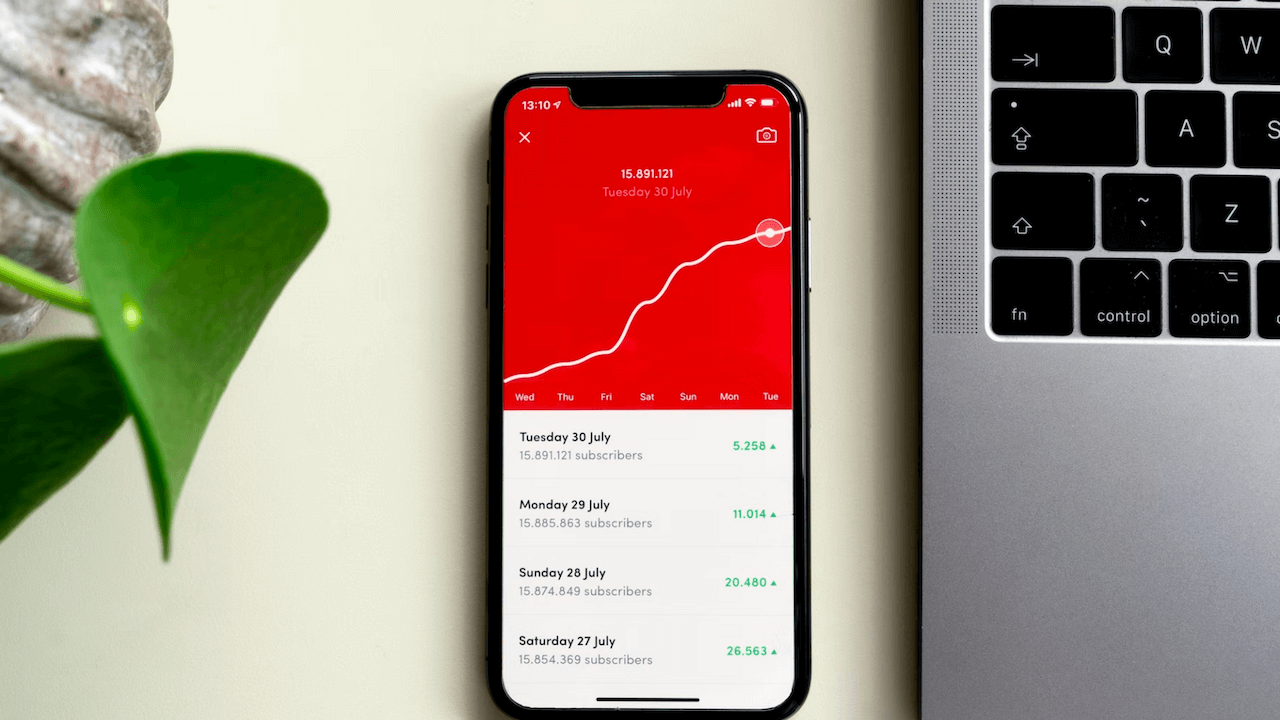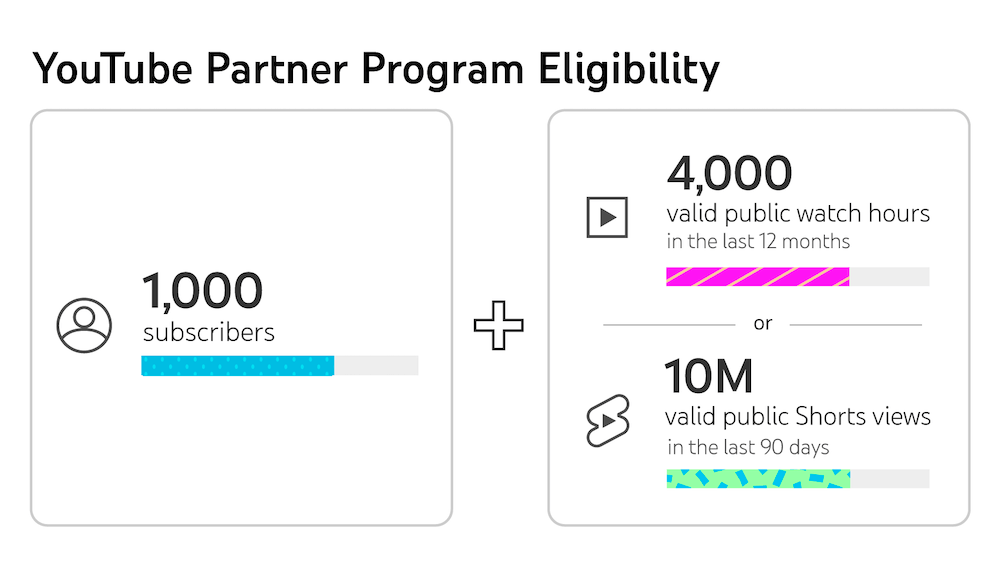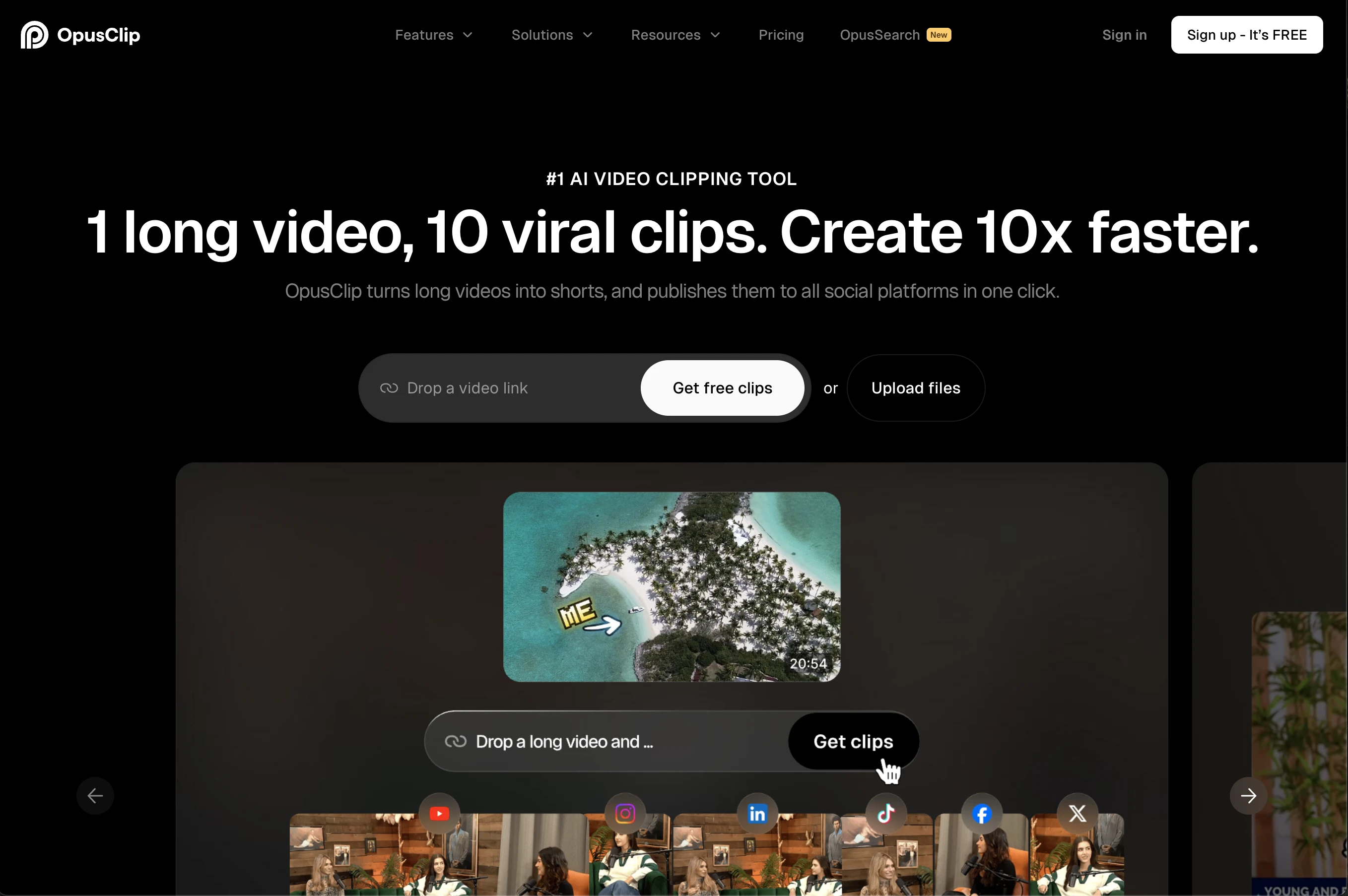YouTube Shorts Monetization: What You Need to Know

YouTube Shorts has become one of the fastest-growing short-form video platforms, with more than 2 billion monthly logged-in users. As creators and marketers rush to take advantage of its reach, one big question looms: How do you make money from Shorts?
This guide breaks down everything you need to know about YouTube Shorts monetization in 2025. Whether you're a seasoned YouTuber or just getting started, we'll also show you how tools like OpusClip can help you turn long-form content into high-performing Shorts—faster and easier than ever.
Main Takeaways:
- YouTube Shorts monetization is based on ad revenue sharing through a pooled Creator Fund
- To monetize Shorts, creators must join the YouTube Partner Program (YPP) and meet specific eligibility requirements
- Eligible content must be original, policy-compliant, and advertiser-friendly to qualify for monetization
- Even without YPP, creators can earn through affiliate marketing, merch sales, and content funnels
- Tools like OpusClip help creators scale their Shorts strategy by repurposing long-form videos efficiently
How Does YouTube Shorts Monetization Work?

In early 2023, YouTube transitioned away from its $100M Shorts Fund to a new ad revenue sharing model within the YouTube Partner Program (YPP). This system now allows eligible creators to earn money from ads displayed in the Shorts Feed.
YouTube Shorts monetization is powered by an ad revenue-sharing model. Rather than linking ad earnings to individual videos, YouTube pools all ad revenue generated from the Shorts Feed and distributes it based on a creator's overall contribution to total Shorts views. Here's how the process works:
- Ad sales: YouTube sells ad space to advertisers and places those ads between Shorts in the feed.
- Revenue pooling: All revenue from these ads is collected into a central Creator Pool. This is different from traditional YouTube monetization, where each video generates its own revenue.
- Initial fund allocation: YouTube allocates a portion of the pooled revenue to music licensing. If a Short contains no music, 100% of its eligible ad revenue goes into the Creator Pool.
- Music licensing allocation: If a Short contains one music track, 50% of the revenue associated with its views goes to music rights holders, and 50% to the Creator Pool. If it has two music tracks, 66% goes to music rights holders and 34% to the Creator Pool.
- Creator fund allocation: YouTube calculates each creator's share of the Creator Pool based on their contribution to the total number of Shorts views during a given payout period. For example, if your Shorts received 4% of all eligible views for that month, you'll be allocated 4% of the Creator Pool.
- Fund payment: Each creator receives 45% of the revenue attributed to them from the Creator Pool. YouTube retains the remaining 55% to cover platform and licensing costs.
This monetization model rewards creators who consistently publish engaging, original content, especially those who avoid music licensing fees and generate a high volume of views. By combining simplicity and scalability, YouTube Shorts monetization offers an accessible way for creators to turn short-form video into sustainable income.
How to Make Money on YouTube Shorts with YPP
Monetizing your Shorts through the YouTube Partner Program involves a few essential steps, starting with eligibility and ending with activating the features that help you earn.
Step 1: Meet the eligibility requirements

Before you can apply to the YouTube Partner Program, you'll need to make sure your channel meets the following criteria:
- You comply with all of YouTube's channel monetization policies
- You live in a country or region where the YPP is available
- You have no active Community Guidelines strikes
- You’ve enabled 2-Step Verification on your Google account
- You’ve linked your channel to an active AdSense account
In addition to these foundational requirements, your channel must also meet one of the following performance milestones:
- 1,000 subscribers and 10 million valid public Shorts views in the past 90 days, or
- 1,000 subscribers and 4,000 valid public watch hours on long-form videos
Once you’ve hit these thresholds, you're eligible to apply.
Step 2: Submit your application
You must submit your application through the YouTube Studio (YTS) app, which you can download from the Apple or Google Play store or access via a web browser. The sign-up flow has three easy steps:
- Go to the Earn tab in YouTube Studio.
- Click Start to review and accept the Terms and Conditions.
- Click Start again to link your existing AdSense account or create a new one.
After submitting your application, your status will show as “In Progress.”
Step 3: Undergo the review process
YouTube uses a mix of automated systems and human reviewers to evaluate your channel's content, engagement, and compliance. Most applicants receive a decision within about a month. However, the process can take longer if your channel requires additional review, especially if reviewers disagree and need to conduct multiple evaluations.
If your application is declined, you can reapply after 30 days. Use that time to strengthen your channel by uploading consistent, policy-compliant content.
Step 4: Enable monetization features and start earning
Once accepted into YPP, you can enable monetization features in YouTube Studio. These include:
- Shorts Feed Ads (your share of the Creator Pool)
- Watch Page Ads (for long-form content)
- Super Thanks, Super Chat, and Super Stickers
- Channel Memberships
- YouTube Shopping integrations
To start earning, you'll need to review and accept the terms for each module and configure your ad preferences. All earnings are paid out through your linked AdSense account based on YouTube's payout schedule.
YouTube expects YPP creators to remain active. If you go six months without uploading content or using the Community tab, monetization may be paused—so consistency is key to keeping your earning potential active.
How Much Can You Earn From Making YouTube Shorts?
The amount you can earn from Shorts depends on several factors:
- Total views
- Audience geography
- Licensed music usage
Here's an example:
- If your RPM is $0.03, then 3.3 million views could earn you $100.
- Using two music tracks in your Short? You'll split revenue three ways (two parts to music holders, one part to you).
- Avoiding music? You keep the full share of your portion from the Creator Pool.
💡Want to estimate your potential earnings? Try a YouTube Shorts revenue calculator to project RPM-based payouts.
How to Qualify for Monetization Faster
The requirements for the YouTube Partner Program can seem daunting. Reaching 1,000 subscribers and either 4,000 watch hours or 10 million views in 90 days is a big goal. Here are several ways to increase viewership and engagement to help you qualify faster.
Let's look at the primary ways to meet and exceed your public watch hours, new followers, and view goals.
- Post engaging content regularly: Your Shorts are more likely to appear in a viewer's feed if you publish new content at least once a week and create Shorts that appeal to the YouTube Shorts algorithm. To ensure users watch til the end, consider your audience, their interests, and any trending content within your niche community before creating videos.
- Optimize videos for SEO: Search engine optimization (SEO) is a tool that can help users who are searching for new content find your channel. Identify the main keyword you want your content to rank for and add it to the title of your video. YouTube will see that your video targets that keyword and help you rank higher.
- Choose eye-catching thumbnails: Custom thumbnails can boost your video's click rate (CR) by up to 40%. When more people click on your videos, you get more views. YouTube will rank them higher in search results, so even more people will see your videos. So, get creative and curate custom thumbnail images before publishing new content!
- Host livestreams: Unlike Shorts and pre-recorded content, livestreams allow creators to engage in longer, real-time interactions with their viewers. Hosting a live Q&A session, product demonstration, webinar, or behind-the-scenes look at your channel can help you simultaneously build watch hours and a relationship with your viewers.
- Leverage YouTube Analytics to gain insight: If you implement any of the strategies above, YouTube Analytics will record and report how your watch hours and other engagement metrics have improved because of them. YT Analytics is also the perfect place to gain insight into your viewers' data so you can learn more about their content consumption habits and create videos to suit their interests better.
Other YouTube Shorts Monetization Strategies
There are many other ways to turn your YouTube Shorts into revenue streams, even without ad share access. These off-platform strategies are flexible, scalable, and well-suited to creators in all stages of growth.
1. Promote Affiliate Products
One of the simplest ways to start earning is by using Shorts to promote products you believe in and linking to them with an affiliate URL. Every time someone clicks your link and makes a purchase, you earn a commission.
How to do it effectively:
- Create a short tutorial, demo, or reaction video around the product
- Include your affiliate link in the pinned comment, video description, or bio
- Use services like PearPop, Amazon Associates, or Impact.com to find relevant offers
This strategy works especially well for creators in niches like tech, beauty, fashion, fitness, or home decor, where product discovery is part of the content value.
2. Offer Premium Content or Memberships
If you have a small but loyal audience, you can offer exclusive content outside of YouTube through membership platforms like:
- Patreon
- Ko-fi
- Buy Me a Coffee
What you can offer:
- Behind-the-scenes updates
- Early access to Shorts or long-form content
- Exclusive tutorials, livestreams, or templates
- Access to private communities like Discord servers
This strategy helps you build a predictable, recurring revenue model while strengthening your relationship with core fans.
3. Sell Merchandise and Digital Products

Shorts are a great tool for showcasing merchandise, especially if you’ve built a recognizable brand, slogan, or inside joke with your audience. Use videos to show your gear in action or highlight designs, and direct viewers to your store.
Platforms like Fourthwall make it easy to:
- Sell custom t-shirts, mugs, and stickers
- Offer digital downloads (ebooks, LUTs, templates, etc.)
- Set up a store without needing inventory or upfront costs
Over 50,000 creators use Fourthwall to sell merch and digital goods across niches—from art prints to productivity tools.
4. Use Shorts as Traffic Drivers
Your Shorts don't have to be the final destination—they can be the first touchpoint in a much larger funnel. Use them to:
- Drive views to your long-form YouTube content, where you earn through ads or sponsors
- Lead people to a landing page for your newsletter, course, or consultation offer
- Grow an email list, where you can nurture deeper relationships and pitch higher-ticket services or products later on
A compelling Short with a clear hook and call to action can turn a casual viewer into a customer over time.
How Does Monetizing YouTube Shorts Compare to Other Platforms?
Each platform offers different ways to monetize short-form content. Here's a quick comparison:
- YouTube Shorts: Shares 45% of ad revenue with creators based on views, taken from ads shown between Shorts.
- Snapchat Spotlight: Pays top creators directly, with potential for significant earnings. Product selling isn't allowed on Spotlight but is permitted through their Creator Marketplace.
- TikTok: Uses a Creator Fund that pays based on performance metrics. Creators can also earn through link-in-bio offers and affiliate shopping features.
- Instagram Reels Play: Offers an invite-only bonus program with variable payouts based on performance, volume, and content type.
For technical specifications to optimize your YouTube Shorts, check out our guide on YouTube Shorts Dimensions.
Am I Ready to Monetize YouTube Shorts?
Before jumping into monetization, it's worth asking: Am I actually ready to monetize my Shorts content?
The technical requirements are only one part of the equation. Sustainable monetization depends on more than meeting view counts or subscriber milestones. It requires a solid content foundation built on consistency, relevance, and engagement.
Here are a few questions to help assess your readiness:
- Are you posting consistently (ideally at least once per week)?
- Do your Shorts follow a focused theme or niche your audience recognizes?
- Are your videos optimized with compelling titles, hashtags, and thumbnails?
- Are you using YouTube Analytics to understand what's working and what isn't?
- Are your viewers engaging through comments, likes, shares, or return visits?
If you're answering yes to most of these, you're well-positioned to begin monetizing. But if not, don't worry. Building a successful Shorts strategy takes time, and refining your creative process is part of the journey.
One of the best ways to ramp up consistency and scale your content is with an AI-powered tool like OpusClip. With OpusClip, you can repurpose long-form videos into multiple viral-ready Shorts in just a few clicks. It handles the formatting, captions, and highlight selection automatically, so you can focus on storytelling and growth.

Turn Long Videos Into Shorts That Earn With OpusClip
Monetizing YouTube Shorts is becoming more accessible, with evolving revenue models like ad sharing, affiliate promotions, and creator funds offering new ways to earn. The key to success is consistent publishing, audience engagement, and content optimized for the Shorts format.
Tools like OpusClip make it easier to stay consistent by transforming long-form videos into platform-ready Shorts with captions, formatting, and highlights, all powered by AI.
Try OpusClip for free to streamline your YouTube Shorts strategy and grow your channel with less effort.
FAQs About YouTube Shorts Monetization
How much money can you make from YouTube Shorts?
Earnings from YouTube Shorts vary widely but are often measured by Revenue Per Mille (RPM), which can range from $0.01 to $0.06 per 1,000 views. Your total income depends on your viewership, audience geography, and whether you use licensed music.
How many views on YouTube Shorts to make $100?
To make $100 from YouTube Shorts, you would typically need between 1.6 million and 10 million views, based on an average RPM of $0.01 to $0.06. This number can fluctuate based on various factors like audience location and engagement.
Can I monetize YouTube Shorts without being in the YPP?
No, direct monetization through ad revenue sharing is only available to creators in the YouTube Partner Program (YPP). You can still earn money through other methods like affiliate marketing, brand sponsorships, or selling your own merchandise.
How much do YouTube Shorts pay for 1,000 views?
YouTube Shorts typically pay between $0.01 and $0.06 per 1,000 views, depending on factors like audience location, engagement, and content performance. While payouts can vary, creators with consistent output and strong viewer retention tend to earn more over time.
Which types of content qualify for Shorts monetization?
To be eligible for YouTube Shorts monetization, your content must be original, follow YouTube's Community Guidelines, and meet advertiser-friendly standards. Shorts that reuse other creators' content, include unedited clips from movies or TV shows, or feature hate speech, misinformation, or excessive profanity are not eligible. Using copyrighted music properly is allowed, but it may reduce your share of ad revenue. Staying compliant with these rules ensures your Shorts qualify for revenue through the Creator Pool.

























